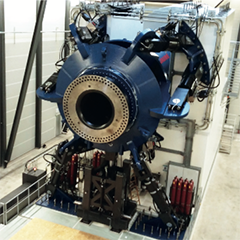Wind power technology is advancing at a fast pace. The demand for full scale test systems is on the rise. All investors and manufacturers in the wind power industry want to make sure that turbines function flawlessly. A malfunctioning turbine is a nightmare, especially on offshore wind farms. PES brings you the latest from the new Peikko and R&D Test Systems partnership, which combines expertise and know-how, giving added value to the customer.
‘Repairing a turbine in offshore conditions is both difficult and costly. That is why the turbines are put through a series of vigorous tests in a controlled environment,’ says Lasse M. Stephansen, Senior Project Manager at R&D Test Systems.
R&D Test Systems is an international engineering company with a strong track record within turnkey test bench solutions for manufacturers and test facilities.
End-Of-Line Test is a procedure which every single turbine has to pass. However, it is the Highly Accelerated Life-cycle Test that makes the engineers’ pulses quicken.
‘During HALT, the machinery is subjected to strain equivalent to an entire 25-year life cycle. This puts the equipment under an enormous amount of stress and loads the test bench more than you can imagine,’ Lasse M. Stephansen explains.
Foundation first
With the increase in wind turbine sizes, the test benches need to cope with ever higher static and dynamic loads. That is when the foundation design becomes extremely important.
R&D Test Systems uses a heavy concrete foundation to reduce vibrations. The stability of the foundation as well as the correct positioning are vital for the test setup to work.
‘The foundation is one of the most important test bench components. If the foundation fails, everything else will fail as well.’
To date, the largest test bench R&D Test Systems has supplied is located at Lindø Offshore Renewables Center in Denmark.
‘The HALT test bench at LORC’s test facilities has a 1500 m3 concrete foundation. Nonetheless, the turbine needs to be positioned with a deviation less than one millimeter – despite the fact that the test bench is 31 meters long and 13 meters high,’ adds Lasse M. Stephansen.



























